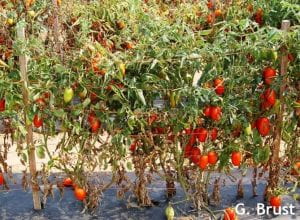Jerry Brust, IPM Vegetable Specialist, University of Maryland; jbrust@umd.edu
I have received samples, gotten reports, and have been in some really ugly tomato fields in the past two weeks. The fields consistently have similar appearances where the bottom third or half of the plants have dead, dark brown, often dried-up leaves (Fig. 1). There have been various reasons for some of the dead tissue. In one case plants had Pith necrosis that we talked about a few weeks ago, another field had bacterial spot that was not controlled very well, in another situation mites were at a very high density, but in many situations there was no plant pathological or insect related reason for the terrible looking field. No pathogen could be found in the stems or roots of the plants and only incidental pathogens or insects on the leaves. What seemed to be happening was a rapid decline of the plants over the last couple of weeks. It appears that the stress of this summer is catching up to some fields as they support a heavy fruit load at this time of the season. Additional factors appear to be lower than needed levels of irrigation and possibly the plants are running out of nutrients. It is hard to put a definitive finger on the cause other than the heat and drought seem to be reducing the plants ability to maintain healthy lower foliage. Much of the fruit on many of these plants is still in remarkably good shape although it goes downhill fast (Fig. 2). The bottom leaves on tomato plants are often used to help fill out fruit when times are tough for the plant, so that these leaves become weakened, yellow and very tough and leathery. This situation seems to be occurring here, but at a much accelerated rate of lower foliage decline. In this weather any additional stress on the plant is going to increase the possibility it declines rapidly. I do not have a sure-fire plan to remedy the situation other than to pick off the fruit load as much as is reasonably possible and increase irrigation levels as well as to feed the plants low concentrations of NPK. The plants are probably not going to recover to any great extent until the heat wave ceases, but you can maintain the plants until you harvest the fruit. The most important thing to do if your field looks like Figure 1 is to take plant samples to figure out exactly what you have. Whether it is a plant disease or insect problem or an environmental one, steps can be taken to remedy the situation, but you have to be sure what you are dealing with first.

 Figure 1. Tomato field with the bottom half of the plants with dead leaf tissue
Figure 1. Tomato field with the bottom half of the plants with dead leaf tissue


